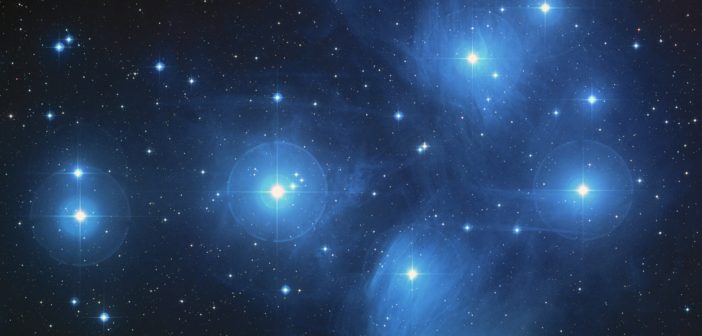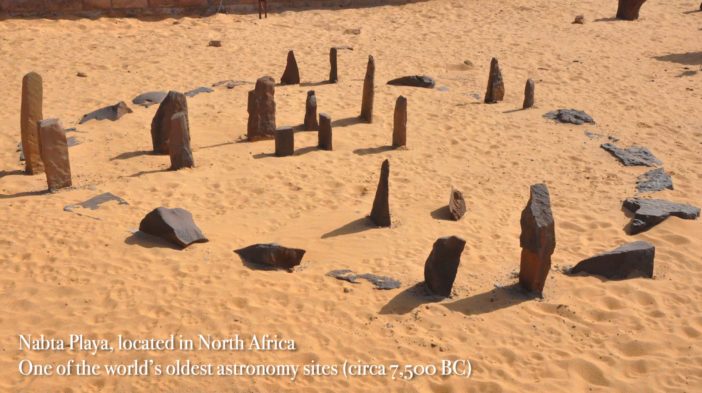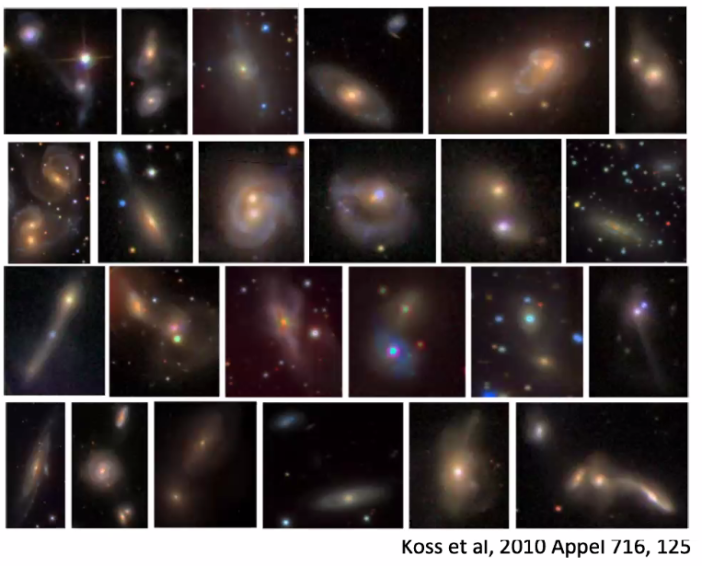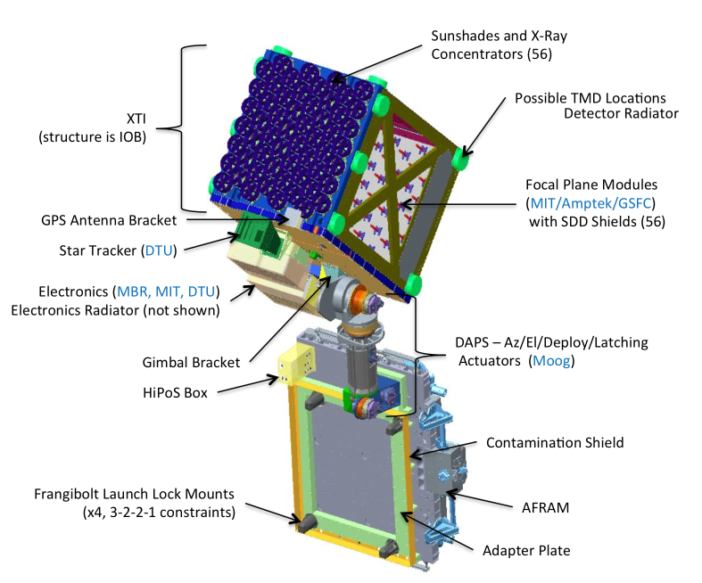Editor’s Note: This week we’re at the 241st AAS meeting in Seattle, WA, and online. Along with a team of authors from Astrobites, we will be writing updates on selected events at the meeting and posting each day. Follow along here or at astrobites.com for daily summaries, or follow @astrobites on Twitter for live coverage. The usual posting schedule for AAS Nova will resume on January 18th.
Table of Contents:
- Plenary Lecture: Allison Kirkpatrick (University of Kansas)
- Press Conference: New Developments in the World of Planets
- Plenary Lecture: Nia Imara (University of California, Santa Cruz)
- ExoExplorers Special Session
- Press Conference: Stars and Their Activity
- Henry Norris Russell Lecture: Richard Mushotzky (University of Maryland)
- HEAD Bruno Rossi Prize Lecture: Keith Gendreau and Zaven Arzoumanian (NASA Goddard Space Flight Center)
Plenary Lecture: Allison Kirkpatrick (University of Kansas) (by Yoni Brande)
Everything I Need to Know About AGN I Learned in this Plenary – Allison Kirkpatrick (Univ. Kansas)
Prof. Allison Kirkpatrick is an expert in active galactic nucleus (AGN) observations and is currently a professor at the University of Kansas, where she leads a vibrant research group and heads the KU REU program. Prof. Kirkpatrick is also deeply involved with early JWST AGN science through the JWST Cosmic Evolution Early Release Science (CEERS) collaboration. Astrobites’s live tweeting of her plenary talk can be found here.
Prof. Kirkpatrick began by highlighting her close collaborators, postdocs, and students, without which none of the groundbreaking work happening in her group would be possible.
AGN are the accreting supermassive black holes (SMBHs) at the centers of galaxies. For example, the SMBH in Messier 87, the first target of the Event Horizon Telescope’s imaging campaign, is roughly the size of the solar system (~300 AU), while its host galaxy is more than 10 million times larger. Despite this disparity, SMBHs often have significant impacts on their host galaxies. Observationally, we can see their indirect effects, such as jets and radio lobes, but we can also classify AGN by their direct properties, such as the presence or absence of broad emission lines.
Finding AGN
We can find AGN by observing in several different bands, anything from the X-rays down into the radio. Different parts of the AGN structure (the dusty torus, corona, BH accretion disk, or clouds in the broad and narrow line regions) tend to emit in specific regions of the electromagnetic spectrum. High X-ray emission from the incredibly hot corona is a good specific tracer of AGN, but X-rays are often absorbed by gas in the interstellar medium, making this method relatively incomplete. Cooler temperatures in ionized clouds lead to broad optical emission lines, but can also be obscured, and spectra are expensive. Narrow lines come from the accretion disk, but some (like H-alpha and H-beta) are also characteristic of star formation, requiring specific line ratios to diagnose AGN versus star forming galaxies. The hot dust in the torus is an infrared emitter (with a classic power law), but it needs to be separated from cold dust in the rest of the galaxy. A major benefit is that infrared AGN aren’t obscured by geometry or other structures in the host galaxy. JWST photometry will be able to tease these apart, so stay tuned for new samples of AGN from Prof. Kirkpatrick’s group!
Unification
The observational types of AGN have historically been thought to be geometric effects, where different viewing angles give us clearer or obscured views through the AGN’s own structure down towards the black hole. However, this isn’t the only explanation: non-unified models posit that, for example, high AGN accretion rates can blow the torus further away, removing it as a source of emission entirely. High galaxy masses and mergers can also deliver more obscuring gas into the galaxy, blocking emission from the AGN externally. These processes can also change over a galaxy’s lifetime, where initially obscured AGN may clear away the gas and dust blocking them, eventually transitioning to an unobscured state.
Mergers
When two gas-rich galaxies collide, the merger process compresses their gas and triggers bursts of star formation. In addition, the merger shunts gas towards their centers, massively growing their SMBHs. Recent studies have shown that this gas also obscures the AGN and is correlated with the dust content of the merging galaxies. However, recent studies have also shown that while mergers are sufficient to fuel AGN, they’re not necessary, with half of the observed low redshift quasars in the Stripe82 sample not present in merging galaxies.
Feedback
Strong AGN emission isn’t just a good observational tracer, but it can also drive powerful winds throughout the galaxy. These winds have been theorized to be able to quench star formation, but it’s hard to definitively measure the mass outflows from these winds. Since star formation also consumes lots of gas mass, AGN winds may not actually be sufficient to quench galaxies, especially at high redshift. AGN can also heat dust throughout the rest of the galaxy, and this itself may also be enough to quench star formation. Since dust and gas tend to coincide, AGN-heated gas may also be present, which has been shown observationally. Each of these feedback mechanisms could explain star formation quenching. While this assumes star formation declines in AGN host galaxies, observations of infrared AGN and X-ray AGN imply that both populations may form stars at typical rates.
The Oddballs
Not all AGN are typical or well-behaved. Prof. Kirkpatrick’s group has identified a population they call “Cold Quasars”: high-luminosity AGN with significant amounts of cold gas and lots of dust (but totally unobscured!)
Inclusion
Closing out her plenary, Prof. Kirkpatrick highlighted some major societal concerns in our field. We can’t separate scientists from their science, and who gets to do science is as important as the discoveries they make. Diversity in the field is low, and historical trends have made astronomy a less-than-hospital place for astronomers of marginalized identities, including but not limited to non-white, non-male, neurodivergent, disabled, queer scientists. These scientists often shoulder disproportionate service efforts, are intentionally or implicitly devalued, and have harder times getting funded.
Luckily, this is a solvable problem. There are great resources available to marginalized students to help find their cohorts, including Black in Astro, NSBP, SACNAS, the Astro Outlist, and others! Allies can also do their best to amplify the voices of our marginalized peers, make our conferences and classrooms more inclusive and accessible, value service work alongside research and teaching for hiring, tenure, and funding, educate ourselves on institutional barriers and how to dismantle them, and learn how to mentor all students effectively. Prof. Kirkpatrick closed with a strong statement: “Our field will only be truly accessible when we decide that people matter more than black holes.”
Press Conference: New Developments in the World of Planets (by Isabella Trierweiler)
Patrick Taylor, discussing radar on the Green Bank Telescope
Patrick Taylor kicked things off by introducing the new radar capabilities of the Green Bank Telescope (GBT). The GBT is currently the world’s largest steerable radio telescope, and it recently got its first prototype radar system, built in collaboration with Raytheon. The new transmitter has less power than a microwave but has already generated some impressive results! To image objects, the GBT works in conjunction with the Very Long Baseline Array (VLBA), with the GBT as a transmitter and VLBA as the receiver. This system resulted in the highest resolution image of the Moon ever taken from Earth, as well as a detailed image of the Tycho crater. The team also demonstrated the GBT transmitter’s use in small-body science by detecting an asteroid five times farther away than the Moon!
Many in the audience were curious about how the GBT system will compare to the recently collapsed Arecibo telescope. Dr. Taylor noted that the GBT is a much smaller telescope, but it does have more flexibility as it is fully steerable (Arecibo had a steerable receiver but the base was built into a sinkhole). He also pointed out the GBT will continue to be used in partnership with the VLBA and eventually the ngVLA. which will bring the whole system’s capabilities in range of Arecibo’s. Designs for the final radar system for the GBT are still in the works, but once the radar system is completed, the GBT could be used for detailed geology and dynamics studies, tracking of space debris and planetary defense, small-body science, and more!
Emily Gilbert, sharing a TESS earth-sized planet in the habitable zone
Emily Gilbert, a postdoc at NASA’s Jet Propulsion Laboratory, presented the exciting discovery of the second known Earth-sized planet in a star’s habitable zone! The habitable zone is the area around a host star that is warm enough for planets to host liquid water. Dr. Gilbert used data from TESS to study the planetary system TOI 700. There were previously three known planets in the system, including planet d, the first Earth-sized planet discovered in the habitable zone. Dr. Gilbert analyzed 14 transits’ worth of data in order to detect the new habitable zone planet, which is slightly smaller than Earth and has an orbital period of 28 days.
TOI 700 is scientifically interesting because the host star is very bright and relatively nearby, and the star appears to be fairly inactive, so it should be a very good candidate for follow up observations! Since the system has planets both within and outside of the habitable zone, detailed studies of this system could help astronomers better understand how planets can follow very different evolutionary tracks after being born in the same protoplanetary disk. Dr. Gilbert says further observations of the system are already in the works! She already has 100 hours on ESPRESSO, a spectrograph at the VLT, to calculate masses for the four planets.
Rob Zellem, announcing the launch of Exoplanet Watch, a citizen science program
Exoplanet Watch is now open to general audiences! The program involves amateur astronomers and members of the general public in the search for exoplanets, with the goal of combining the power of many small telescopes to more efficiently monitor exoplanet transits. Precise transit timings are really crucial for studying exoplanet atmospheres, and now anyone can help out with these studies! Folks with their own telescopes can sign up to contribute data to the project, and anyone without telescope access can help to process the data. All data contributed to the project will be immediately available to everyone, and anyone who volunteers to observe for Exoplanet Watch will be a co-author on any scientific papers that use the data. Exoplanet Watch carried out a test campaign in 2021, combining data from 24 facilities to construct a transit light curve, something that would have taken 2 hours of JWST observing time! Now that the program is open, astronomers will even be able to request observations for particular systems, and will get results more quickly without needing to wait to receive time on a major telescope. The whole system is a really novel way to approach research, allowing astronomers, amateur observers, and the public to all work more closely and collaboratively on astronomy projects. If you would like to get involved in the citizen science project, you can sign up for the Exoplanet Watch Slack here to get started!
Sasha Hinkley, presenting the first directly imaged Gaia Exoplanet
Finally, Sasha Hinkley showed the first direct images of a Gaia Exoplanet, HD206893c. The host star was known to have a circumstellar disk, so it was a promising place to look for exoplanets. The Gaia mission takes very precise measurements of stellar positions in the sky, finding planets based on whether the stars wobble. HD206893 was already known to host one planet, but Gaia data suggested there might be another one, so the team turned to precise imaging to find it. They used the GRAVITY instrument on the VLT to image the system, confirming the orbit of the previously discovered planet and making the discovery of the second planet! The new data is incredibly precise — Dr. Hinkley likens it to observing a dime from 60,000 miles away. The discovered planet is very unique — in size it is right on the border between planets and brown dwarfs (and will hopefully help astronomers better understand the differences between the two groups), and there is evidence that it may have nuclear burning ongoing in the core!
Live tweets for this session by Isabella Trierweiler.
Plenary Lecture: Nia Imara (University of California, Santa Cruz) (by Pratik Gandhi)
In her tour de force plenary talk, “A Star is Born,” Prof. Nia Imara provided a comprehensive review of the complex and important field of star formation out of molecular clouds, the relevant open questions, and potential resolutions to those questions. Dr. Imara, a professor at UC Santa Cruz, was the first Black woman to get an astrophysics PhD from UC Berkeley, and she is also an artist, community organizer, and founder of the non-profit Onaketa, which provides free STEM tutoring to Black and brown youth. In a fun yet poignant moment, she kicked off her plenary by taking a selfie with the entire audience and then acknowledged her ancestors, family, and teachers/mentors who have guided her over the years.
Molecular clouds are the birthplaces of stars and an important intermediate regime between galaxies and stars. Dr. Imara pointed out how difficult star formation is to fully understand, because it’s a complex, multi-scale process involving many different physical processes like gravity, fluid dynamics, magnetism, and chemistry. Molecular clouds are the first steps in the process of star formation, as the coldest and densest, and thus self-gravitating, regions of the interstellar medium. A typical molecular cloud is composed of atomic hydrogen (HI), molecular hydrogen (H2), other molecules like carbon monoxide (CO), and dust.
Next, Dr. Imara posed some of the biggest open questions in the field of star formation, such as:
- How do stellar nurseries form and evolve?
- What is the role of galaxy environment in star formation?
- What is the nature of star formation in the early universe?
- Why do stars have the masses they do?
- How does star formation depend on the structure of molecular clouds?
A really important idea in the field of star formation is the Kennicutt–Schmidt Law, the idea that star formation rates in galaxies are correlated with the distribution of hydrogen gas in them. Molecular clouds tend to be associated with the highest-surface density of HI gas, and thus are thought to be the setting for most of the star formation in galaxies. Dr. Imara’s work in 2016 implied that turbulence in atomic gas is sub-sonic or trans-sonic, and that HI surface density plays a key role in setting the total mass of molecular clouds. Additionally, although the Kennicutt–Schmidt relation applies to galaxies on large scales, it breaks down when you look at smaller scales. The answer here might lie in cloud ages/lifetimes and whether stellar feedback has had enough time to disperse the cloud after star formation.
Dr. Imara highlighted the PHANGS collaboration, one of the most important surveys of molecular clouds and molecular gas in star-forming galaxies outside of the Milky Way. The image below shows the massive improvement in resolution that PHANGS provides relative to older surveys! One of the key results from PHANGS shows higher surface densities of gas in galactic centers, possibly due to bars funneling gas into the centers. Similarly, PHANGS sees higher gas densities in spiral arms relative to the inter-arm regions.
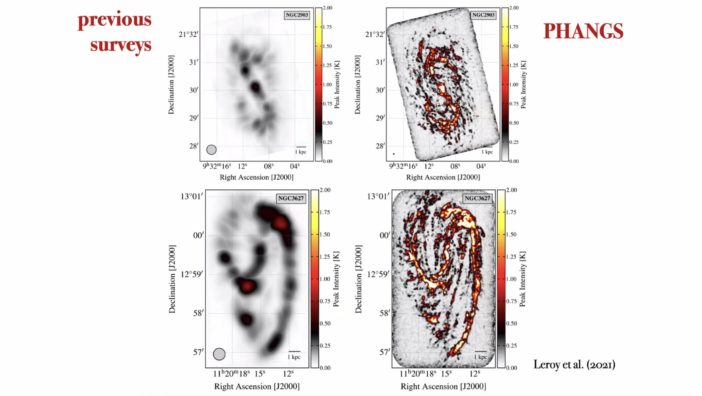
A slide from Dr. Imara’s plenary talk at AAS 241. Comparing PHANGS survey with previous images, it highlights the increase in spatial resolution. [Adapted from Leroy et al. 2021]
Next, Dr. Imara highlighted the rapid onset of star formation in the early universe, which has been discovered in recent years and was unexpected. ALMA and JWST have observed galaxies at very early times with large masses, lots of dust, and rapid star formation.
On a related note, she highlighted the important concept of the initial mass function (IMF). IMF refers to the distribution of stellar masses at formation, which “impacts nearly every area in astronomy,” says Dr. Imara. Its importance cannot be understated, but we still don’t fully understand all of the ideas behind what causes it! STARFORGE, a suite of cutting-edge simulations of molecular clouds and star formation, has shown that stellar feedback and jets from protostars is crucial for determining the resultant IMF of the stars being born, thus making it a self-regulating process.
Segueing into discussing her recent work, Dr. Imara mentions a major challenge in the field: how do we infer 3D properties of molecular clouds from 2D observations? Well, she and her team had the idea of creating 3D-printed stellar nurseries to visualize the properties of molecular clouds! Dr. Imara is looking at the intersection of art and science to understand how various physical properties affect star formation and the structure of molecular clouds. She and her team ran simulations and then used them to generate the 3D prints. This process helped them determine that what appears to be a gas filament can often be a 3D sheet or pancake-like structure of gas.
In her concluding remarks, Dr. Imara highlighted her nonprofit Onaketa that provides free STEM tutoring to Black and brown children. She also highlights the astronomy that her ancestors and people started studying thousands of years ago. “Star formation provides us with a compelling metaphor — we’re all connected across large scales of space and time,” she concluded.
Live tweets of this session by Pratik Gandhi.ExoExplorers Special Session (by Briley Lewis)
This afternoon, early career scientists from the NASA ExoExplorers program gathered to discuss their perspectives on diversity, equity, and inclusion efforts in astronomy. These talks explored various dimensions of diversity in astronomy, including race, socio-economic status, disability, gender identity, first-generation status, and more.
Caprice Phillips, graduate student at The Ohio State University and vice president of Black In Astro, shared recent updates on the Black In Astro (BIA) organization and how people can get involved in upcoming events. You may be familiar with BIA from their collaborations with us here at Astrobites! David Coria, graduate student at University of Kansas, highlighted minority-focused academic success programs, including a few important to his career: the K-State Developing Scholars Program, the McNair Postbaccalaureate Program, and the Hagan Scholarship Foundation. Coria recommended that faculty build trust with their students and be understanding of obstacles they have faced, and be willing to take on students from academic success programs.
Kiersten Boley, also a graduate student at The Ohio State University, discussed the classic description of the “pipeline” in academia, suggesting that not only is it leaky, but also that it begins even before college. Income and opportunities for science education are deeply intertwined, and begin affecting kids at a young age — the same young ages when they are forming their science identities. Boley suggested that outreach efforts should target these younger kids at lower-income schools, providing them opportunities they may otherwise not experience.
Dr. Kaitlin Rasmussen (who has been featured before on Astrobites!) explored the experiences of trans, non-binary, and other astronomers beyond the gender binary, as also discussed in their Astro2020 White Paper. Rasmussen listed five flaws in astronomers’ studies of gender in the field: that in these studies gender is white, observable, discrete, a statistic, and inconsequential. They recommend involving sociologists in any studies of gender in the field and compensating marginalized students / colleagues for their expertise on their lived experiences.
UCLA grad student and Astrobites writer Briley Lewis (yep, that’s me!) spoke on disability and accessibility, which Astrobites has great resources on in our Beyond bites. I shared my experiences organizing planetarium shows for Deaf and blind audiences, and with the recent University of California strike. Lastly, UNC Chapel Hill grad student Amy Glazier talked about her experiences as a first-generation college student, and the variety of barriers faced by those without the institutional know-how and lots of unknown unknowns about how to navigate higher education. “Why is it on us to justify our [marginalized students’]presence instead of institutions to justify our absence?” Glazier said. “Stop treating students from marginalized groups as problems, and start treating them as people.”
Press Conference: Stars and Their Activity (by Macy Huston)
Chih-Chun “Dino” Hsu (Northwestern University) kicked off this afternoon’s press conference with the “Discovery of the Shortest-Period Ultracool Dwarf Binary.” Ultracool dwarfs are low-mass stellar/sub-stellar objects with temperatures below 3000K. Binary systems, particularly those with short periods, are important for creating accurate theoretical models. Only three short-period ultracool dwarf binaries were known before this discovery. Keck observations of the LP 413-53 AB system show a radial velocity signal indicating a 20.5-hour orbital period. This pair’s close-in orbit is comparable to the distance between Jupiter and the Galilean moons. It is unlikely that the objects formed this close together. Two more likely scenarios are orbital evolution and scattering caused by an (ultimately ejected) tertiary companion.
Next up was “To Rain or Not to Rain: Correlating Solar Flare Class and Coronal Rain Statistics” from Kara Kniezewski (United States Naval Academy). Magnetic field line reconnection causes solar flares that heat up plasma, causing it to expand then “rain” back down to the surface. The team analyzed 240 solar flares from 2011 to 2019 (Solar Cycle 24) to track post-flare rain occurrence and duration. The data show a correlation between higher flare strength and higher rain occurrence and duration. They also found that these post-flare rains can predict future solar activity. More powerful flares correspond with higher starspot coverage. While this “rain” effect was known to exist for a while, this work finally examined the issue in detail and established the statistics of post-flare rain in the astrophysical literature.
The third presentation came from Marina Kounkel (Vanderbilt University): “Relating Angular Momentum Evolution and Gyrochronology for Young Stars in the Field.” Stellar ages are typically measured in the context of a cluster of stars that formed together. Based on the population’s evolution, best visualized on an HR diagram, the cluster’s age can be estimated. Gaia has identified thousands of new clusters, allowing for more of this type of study. However, billions of main sequence stars exist in the field, rather than their birth clusters, so we need another method to measure their age. By tracking brightness variability due to starspots, we can measure the rotation periods of stars with telescopes like TESS. With mass and radius data, in addition to period measurements, angular momentum can be estimated. Angular momentum decreases with stellar age, which allows these “gyrochronology” measurements to predict the ages of field stars. This project produced an empirical grid for gyrochronology based on TESS data.
Next, Anastasios Tzanidakis (University of Washington) presented the “Discovery of the Deepest and Longest Known Blinking Giant Star Gaia17bpp.” (Press release) The star’s interesting activity was detected with Gaia, which measures the position and brightness of millions of stars in the galaxy. The cool M-giant star was notable for its odd optical light curve, where it gradually brightened ~4 magnitudes over ~3 years. Archival data back to the 1950s showed a relatively flat light curve for the star until 2013, when it very gradually dimmed. This dramatic dimming event may be explained by a dusty disk eclipsing it, where the disk may host a hot star in its center. If the two stars are gravitationally bound, the orbital period should be ~100–1000 years, so these eclipse events are very rare. This calls back to a similar system, Epsilon Aurigae, which shows dramatic 2-year eclipses every 27 years. These two systems (along with two others) belong to an emerging population of binary stars with dramatic dimming events which future surveys like LSST should help characterize.
The final presentation of this session was “Starspots and Magnetism: Testing the Activity Paradigm in the Pleiades and Messier 67 Star Clusters” from Lyra Cao (The Ohio State University). Cool stars show a lot of magnetic activity and starspots, which can affect their interior structure. In order to create accurate models of these stars, magnetism has to be accounted for. The team developed a method to directly measure the magnetism of stars by separating out the ambient surface and the starspot signatures in their spectra. This allows for magnetic studies in open clusters, where stars all have similar ages and compositions. Rapidly rotating stars show stronger magnetism and starspot coverage, but at a high enough speed, this effect saturates, and starspot levels remain flat. The team found some anomalous stars whose starspot coverage appears too high for their relatively slow rotation periods. When modeling eclipsing binary stars, their radii can appear inflated compared to real radius values. Accounting for starspots can allow for more accurate radius and temperature estimates, which also enables more accurate radius measurements for transiting planets. Starspot activity is most powerful for low-mass stars and stars turning off of the main sequence, then fades away in the stellar evolution process as stars dramatically expand and slow their rotation.
Live-tweet thread by Macy Huston
Henry Norris Russell Lecture: Richard Mushotzky (University of Maryland) (by Graham Doskoch)
The Henry Norris Russell Lectureship is presented to an astronomer who has distinguished themself throughout the course of their scientific career. This year’s recipient was Prof. Richard Mushotzky, of the University of Maryland, whose career has paralleled the course of the field he has dedicated his life to: X-ray astronomy. He has seen everything from its serendipitous arrival and exciting early years to the earliest X-ray observatories to the leaps and bounds achieved by the Chandra and XMM-Newton missions. Prof. Mushotzky summarizes where the field is right now as we move into an age of X-ray astronomy heralded by several new instruments.
He began his talk by taking us back to the early days of X-ray astronomy with the launch of the Uhuru satellite. Its X-ray observations gave astronomers a new toy in their toolkit to study active galactic nuclei (AGN), supermassive black holes which are accreting matter and spewing out relativistic jets, high-energy emission, and more. When Uhuru was launched in 1970, AGN were still poorly understood; while we know much more about them today, plenty of questions remain. How are the different kinds of AGN related? How do they interact with their host galaxies? How common are they?
More progress on these problems was made with the HEAO program in the late ‘70s and early ‘80s, which Prof. Mushotzky worked on after finishing graduate school. The HEAO missions studied, among other things, the variability of AGN and were also able to take — in Prof. Mushotzky’s words — “boring” spectra. More progress was made on the spectroscopic front towards the end of the century when Chandra and XMM-Newton launched; over the past couple decades, they have remained stalwarts of the field.
Prof. Mushotzky turned to some of today’s state-of-the-art X-ray astronomy, focusing on the work he and his colleagues have done recently on AGN, much of which has been enabled by the Swift Observatory’s Burst Alert Telescope (BAT). Some of his work has involved studying emission from what are called radio-quiet AGN – many of which can, nevertheless, be detected with radio telescopes like ALMA. Their observations at high frequencies (for radio waves, at least) showed an unexplained component of AGN spectra not easily attributed to known high-energy processes.
They also noticed interesting relationships between active supermassive black holes and their host galaxies. A galaxy is more likely to host an AGN if it contains more molecular gas; conversely, it also turns out that galaxies with AGN are more likely to have large molecular gas reserves. Prof. Mushotzky and collaborators also found that AGN hosts tend to have undergone more mergers with other galaxies; he showed the mosaic below as an example of how spectacular these mergers can be.
The final section of Prof. Mushotzky’s lecture was dedicated to what the future holds for X-ray astronomy. Two major missions headline the decades to come. This May, the XRISM mission will be launched, equipped with imaging and spectroscopic instruments to study soft x-ray emission. It will be followed in 2032 by the AXIS satellite, which will be roughly 10 times as sensitive as Chandra. AXIS will address many of the priorities of x-ray astronomy determined by the Astro2020 decadal survey — truly a telescope for the 21st century.Live tweets of this session by Graham Doskoch.
HEAD Bruno Rossi Prize Lecture: Keith Gendreau and Zaven Arzoumanian (NASA Goddard Space Flight Center) (by Ryan Golant)
Each year, the Bruno Rossi Prize is awarded for “a significant contribution to High Energy Astrophysics, with particular emphasis on recent, original work.” This year, the Rossi Prize was given to Keith Gendreau, Zaven Arzoumanian, and the team responsible for the Neutron Star Interior Composition Explorer (NICER), a revolutionary X-ray telescope launched in 2017. In this plenary lecture, Dr. Gendreau and Dr. Arzoumanian summarized NICER’s capabilities and goals and provided a glimpse into the deluge of fascinating results emerging from NICER’s data.
Dr. Gendreau opened the talk by thanking the whole NICER team, including the nearly 100 scientists in the science working group; later in the talk, Dr. Arzoumanian expressed similar gratitude, stating that “it’s a privilege everyday to work with the talented people who work with NICER.”
Dr. Gendreau’s portion of the talk largely focused on NICER’s unique design specifications. All of NICER’s optics are contained within a small box of roughly one cubic meter, deemed the X-ray Timing Instrument (XTI); the XTI contains 56 densely-arranged concentrator mirrors and sunshades, focusing X-ray emission onto an array of 56 detectors. Since NICER’s original goal was to observe point sources like neutron stars — and not to produce large-area images — the telescope’s instrumentation sacrifices field of view in favor of high throughput and mobility, collecting as many X-ray photons as possible; the XTI can detect individual photons with an energy resolution on par with the best CCD detectors and a time resolution of less than 100 nanoseconds. The XTI is also attached to a highly flexible mount, allowing the instrument to slew quickly and precisely to capture a target’s position down to an arcminute or better.

A view of the Neutron star Interior Composition Explorer (NICER), seen at the center of this image, in its berth on the International Space Station. [NASA]
After reviewing NICER’s key capabilities, Dr. Gendreau passed the mic to Dr. Arzoumanian to talk about NICER’s science results. The initial goal of NICER was to probe the structure, dynamics, and energetics of neutron stars — “the most outrageous objects most people have never heard of.” We currently don’t have a clear picture of what goes on within a neutron star, since the extremely high densities (twice the density of an atomic nucleus) yield matter with exotic properties. However, by measuring the masses and radii of neutron stars (which turns out to be a formidable challenge), one can make inferences regarding the interior composition — stiff cores generally result in larger stars, while fluid cores give smaller stars. By carefully analyzing the X-ray pulses emitted by the millisecond pulsars PSR J0030+0451 and PSR J0740+6620, the NICER team was able to obtain reliable masses and radii for these two neutron stars, thus placing unprecedented constraints on neutron star interiors — favoring a stiff core. Upon the release of NICER’s data on PSR J0030+0451, Nature published an article declaring that “the golden age of neutron-star physics [had]arrived”; with more neutron star measurements on the horizon, NICER should continue to revolutionize our understanding of these compact objects.
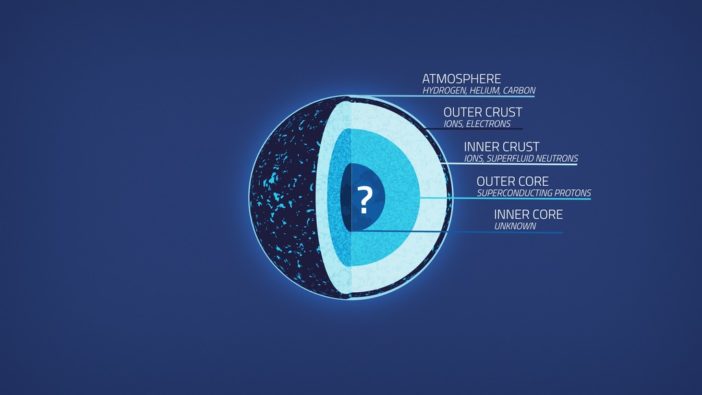
A cartoon infographic showing the structure of a neutron star. [NASA’s Goddard Space Flight Center Conceptual Image Lab]
Dr. Gendreau closed the talk with a brief discussion of NICER’s OHMAN (“On-orbit Hookup of MAXI and NICER”) program. As the name suggests, OHMAN couples NICER to JAXA’s MAXI instrument, another payload on the ISS that’s capable of scanning a huge portion of the sky for X-rays; when MAXI picks up a signal, OHMAN tells NICER to slew immediately towards the source, enabling high-resolution detections of fast transient events. Recently, OHMAN proved invaluable in the study of GRB221009A, the most energetic gamma-ray burst ever detected. Dr. Gendreau concluded by remarking that, with the implementation of OHMAN, NICER has become a dynamic partner in our multi-wavelength and multi-messenger exploration of the universe, well in line with the priorities of the Astro2020 decadal survey.

